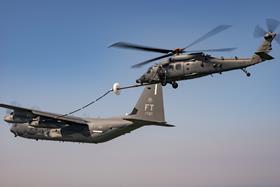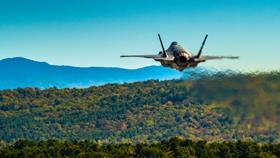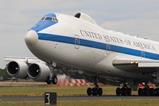After months of disagreement left the Pentagon operating without a full 2024 budget, lawmakers in Washington have agreed to a defence spending plan.
Notably, the fiscal year 2024 budget passed by the Congress provides a significant boost to aircraft procurement, with an additional $3 billion on top of the $40.6 billion requested by the Pentagon.

Elected lawmakers gave final approval to the defence budget on 23 March, which President Joe Biden signed into law shortly thereafter.
The government’s fiscal year began in October, making approval of the 2024 budget some six months behind schedule. Pentagon brass have already submitted their fiscal year 2025 budget requests to Capitol Hill.

Several notable programmes are getting a boost beyond the 2024 procurement figures requested last year by the Pentagon, with aerospace manufacturers including Boeing, Lockheed Martin, Bell, Northrop Grumman, Sikorsky and Pratt & Whitney set to benefit.
Embattled airframer Boeing notched several wins for its defence business in the FY2024 budget, most notably the addition of $1.8 billion to purchase 10 new P-8 Poseidon maritime patrol aircraft for the US Navy (USN).
The navy had not planned on ordering any more of submarine-hunting jets, which are derived from the 737-800 commercial airframe. Budget documents outlining the navy’s 2024 spending plans had indicated the service planned to end P-8 procurement with the 128 Poseidon jets currently in service.
Another Boeing programme, the E-7 Wedgetail airborne early warning and control (AEW&C), is also getting a boost. Congress is providing the US Air Force (USAF) with an extra $200 million intended to “accelerate” fielding the 737NG-based airborne battle management platform, which is replacing the ageing Boeing E-3 Sentry.
Congress has been a major supporter of developing an E-7 programme for the USAF, which selected the Wedgetail as its next-generation AEW&C platform in April 2022.
In the subsequent 2023 defence budget, lawmakers barred the air force from retiring any E-3s until the service had developed an acquisition strategy for the E-7.
Shortly after, the service funded an E-7 rapid prototyping initiative and the first E-3 retirements began in April 2023.

The USN will also be receiving more airborne early warning aircraft, with an extra $413 million approved by Congress to cover two more carrier-capable Northrop E-2D Advanced Hawkeyes.
While the navy’s 2024 budget request did not include an E-2D buy, documents submitted to Congress indicated the service is interested in acquiring six additional aircraft to reach a total fleet size of 125 Hawkeyes.
Elsewhere in carrier aviation, the navy is receiving $675 million to purchase five additional Bell-Boeing CMV-22 tiltrotors. The naval variant of the V-22 Osprey is used to resupply aircraft carriers at sea.
The funds will move the USN toward its CMV-22 target of a 48-aircraft fleet.
Other rotorcraft manufacturers also received a financial boost from the recent legislation, including Boeing and Sikorsky.
Lawmakers appropriated an extra $221 million for the US Army to buy more Chinook heavy-lift helicopters from Boeing, including both the CH-47F and MH-47G special operations variant. The army had already requested $221 million for six Chinooks in 2024, according to spending proposals submitted last year.
In February, the service announced it would pursue an agreement with Boeing for full-rate production of the latest CH-47F Block II variant – a significant win for the airframer.
The USAF also received $400 million in the 2024 budget to fund 10 more Sikorsky HH-60W Combat Rescue Helicopters – the Pentagon’s first purpose-built medical evacuation helicopter.

While the USAF had originally sought to acquire 113 HH-60Ws to replace the HH-60G Pave Hawk, service leaders had tried to end procurement of the type in 2023 with a total fleet of just 75 aircraft.
Congress also approved an extra $60 million in the FY2024 budget that will cover additional UH-60 Black Hawks for the Army National Guard. The army’s FY2024 budget request indicates the service had already planned to spend $736 million on 24 Black Hawks this year.
Sikorsky’s parent company Lockheed will also see additional revenue from the 2024 spending package.
The airframer will see an extra $1.1 billion in revenue to provide the USAF with new C-130J tactical transports. In 2023, 16 of the four-engined turboprops were funded at a total cost of $1.7 billion.
Lockheed will also see a portion of the $451 million Congress approved to buy additional F-35 stealth fighters and spare engines. The fifth-generation jet is powered by the Pratt & Whitney (P&W) F135 propulsion system.
Engine maker P&W was one of the major winners in the FY2024 budget. The company’s Engine Core Upgrade programme to provide capability enhancements to the F135 was fully-funded – with a total of $497 million, according to the RTX subsidiary.
Congress also effectively ended a long-running debate over the future of F-35 propulsion – terminating a programme to develop an entirely new engine for the jet and prohibiting the integration of “an alternative on any F-35 aircraft”.
The latest budget also includes some $2.3 billion to further development of a sixth-generation fighter under the USAF programme known as Next Generation Air Dominance (NGAD).
That funding will also support the development of so-called collaborative combat aircraft – cheaper, autonomous jets the air force hopes to field in large numbers to support the NGAD fighter aircraft.

























